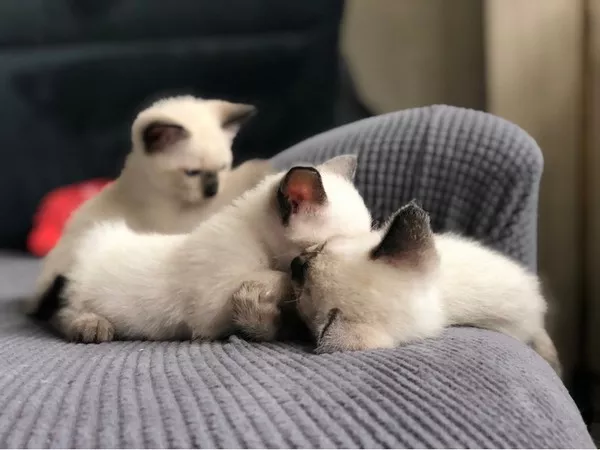A groundbreaking genome sequencing project conducted by researchers at the Texas A&M School of Veterinary Medicine & Biomedical Sciences (VMBS) and a diverse team of collaborators has unearthed valuable information about the evolution of cats. The research sheds light on how various cat species, including renowned ones like lions, tigers, and domestic cats, diverged into distinct species and how genetic changes in cats are linked to survival traits, such as their ability to detect prey through scent.
Published in the journal Nature Genetics, the project involved comparing the genomes of multiple cat species, offering crucial insights into why cat genomes exhibit fewer complex genetic variations, such as DNA segment rearrangements, compared to other mammal groups, such as primates. It also provided a deeper understanding of which segments of cat DNA are prone to rapid evolution and their role in species differentiation.
Dr. Bill Murphy, a professor of veterinary integrative biosciences at VMBS, specializing in cat evolution, explained the project’s goals, saying, “Our aim was to gain a better understanding of how cats evolved and the genetic basis of the differences in traits among cat species. We aimed to harness new technologies to create more comprehensive genomic maps of cats.”
These findings have far-reaching implications for the study of feline diseases, behavior, and conservation. Researchers will now work with a more comprehensive grasp of the genetic distinctions that make each type of cat unique.
Genetic Stability in Cats
One of the central inquiries of the research was why feline chromosomes, which carry genetic information for traits like fur color, size, and sensory abilities, are notably more stable across species compared to other mammal groups.
Dr. Murphy highlighted this genetic stability, stating, “For instance, the chromosomes of lions and domestic cats exhibit hardly any differences. There appear to be far fewer duplications, rearrangements, and other types of variation than what is commonly found in great apes.”
This is in stark contrast to primates, where genetic variation has led to the evolution of different species, including humans and great apes. These genetic variations in primates have been associated with conditions like autism and neurological disorders.
The key to the difference between cats and apes lies in the frequency of a specific genetic element known as “segmental duplications,” which are highly similar copies of DNA segments found elsewhere in the genome. By comparing a wide range of cat species, the researchers discovered that cats have significantly fewer segmental duplications compared to primates, making cat genomes more stable.
Identifying the Key to Genetic Differences
The study unveiled that the center of the X chromosome plays a pivotal role in the genetic rearrangements in cats. A specific repetitive element called DXZ4 within this region is responsible for the genetic isolation of at least two cat species, namely domestic cats and jungle cats. While not a conventional gene affecting physical traits, DXZ4 aids in the three-dimensional structure of the X chromosome and is likely instrumental in cat speciation.
Dr. Murphy elaborated, “By comparing all these cat genomes, we can better measure the rate at which DXZ4 evolved in one species compared to all the others. What we learned is that DXZ4 is one of the most rapidly evolving parts of the cat genome, evolving faster than 99.5% of the rest of the genome. This suggests a strong link between DXZ4 and speciation.”
Insights into Olfactory Genes
The researchers also established clearer connections between the number of olfactory genes, which govern scent detection in cats, and variations in their social behavior and adaptability to different environments. Cats rely heavily on their sense of smell for hunting, making it a crucial aspect of their biology.
Dr. Murphy explained, “Lions and tigers display significant differences in certain odorant genes responsible for detecting pheromones, which convey information about identity, territory, or danger. This variance is linked to their social behavior and habitat.”
While lions are social animals with fewer pheromone-detecting genes, tigers are solitary creatures and possess a more extensive repertoire of these genes. Domestic cats, living in proximity to humans, have lost many olfactory genes, as they don’t need to travel great distances to find their necessities.
The research also highlighted unique traits in specific cat species. For instance, fishing cats, adapted to an aquatic lifestyle in Southeast Asia, retained genes for detecting waterborne odorants, a rare trait among terrestrial vertebrates.
This progress in understanding olfactory genes was made possible through an innovative genome sequencing technique known as “trio binning,” which simplifies the sequencing of complex genome regions.
Implications for Conservation
The study emphasized the significance of recognizing that cat species are similar in some respects but differ significantly. These distinctions reflect their suitability to distinct natural environments, making them indispensable for conservation efforts. Populations of the same cat species in different regions may have developed specialized genetic adaptations to thrive in their respective habitats.
Dr. Murphy stressed the importance of having complete genomes to study essential bodily systems, such as immunity and reproduction, as many of these systems are found in the most challenging sections of the genome. Comprehensive genome assemblies offer valuable insights for researchers studying genetic conditions in various species.
As the research progresses, Dr. Murphy and his team remain committed to employing advanced genome sequencing and assembly technologies to gain a deeper understanding of the world of cats.
This study was conceived by Dr. Bill Murphy, a professor of veterinary integrative biosciences at Texas A&M, and Wes Warren, a professor of genomics in the Bond Life Sciences Center at the University of Missouri. The collaborative effort also involved researchers from the University of Washington, University College Dublin, the Institute for Systems Biology in Seattle, Louisiana State University, and the Guy Harvey Oceanographic Center.



























